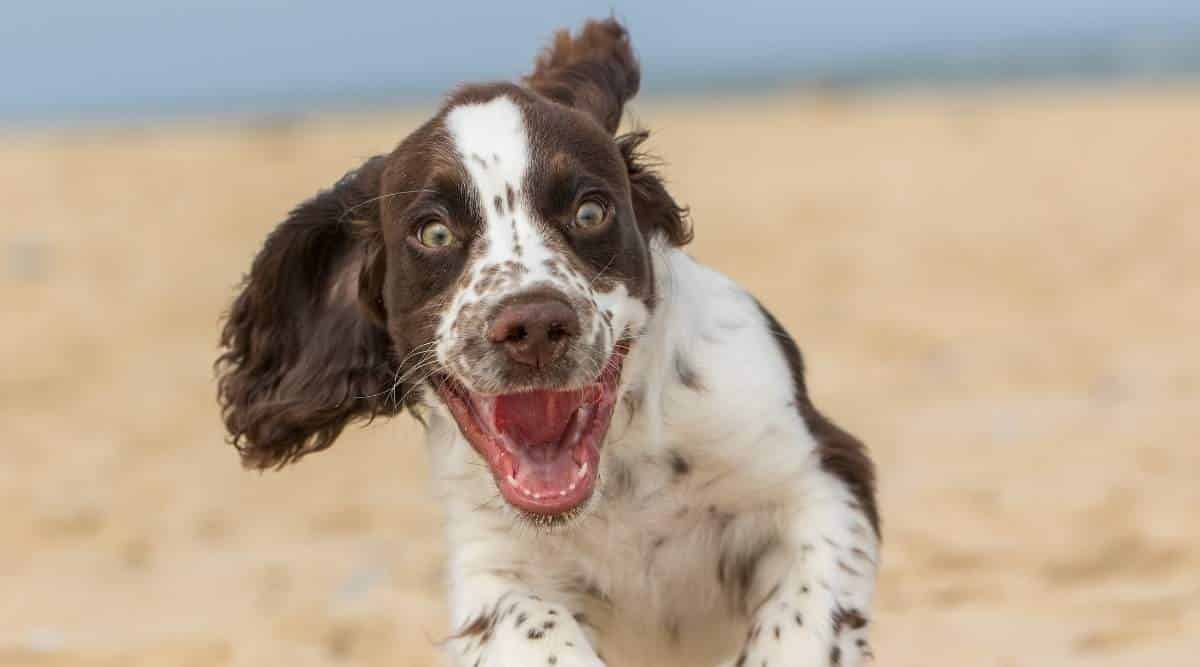Alaskan Malamute Dog Breed Information: Facts, Traits & More
When you purchase through links on our site, we may earn a commission. Here’s how it works.
The Alaskan Malamute is an impressive pooch with his wild wolfy looks and large frame. Many think that getting this guy is a tough cookie who will protect his family at all costs, but this is not the Malamute.
Table of Contents
Nope, this guy is one of the most friendly and sociable canines around and will invite intruders in for dog treats and belly rubs. A very sociable dog, yes, but a formidable guard dog, absolutely not. While Malamutes may bark around people they don’t know, that’s the extent of their guarding abilities. However, their sheer size is a great deterrent if you are after a guard dog.
The Malamute’s big frame comes with additional needs, which means he is not well suited for every family. You’ll need a big home and an even larger yard. You’ll need additional time for long walks, financial stability, and much more. In this guide, you’ll learn all you need to know about the Malamute and if it’s the right breed for your family. Are you eager to find out if he is the canine companion of your dreams?
History
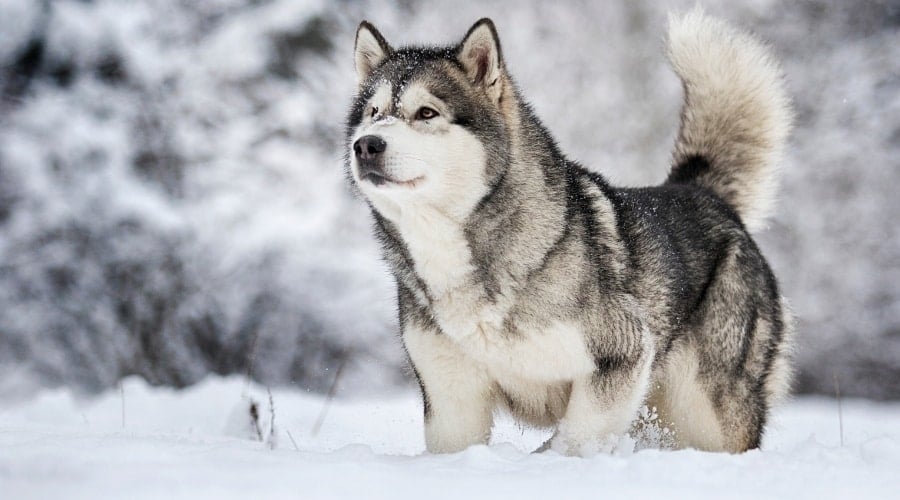
The Alaskan Malamute is an ancient dog breed that descended from domesticated wolf dogs around 4,000 years ago. The Mahlemut Tribe in northwestern Alaska desired a large canine to transport heavy goods across large expanses of ice between tribes. And so they created the breed. He is often confused for his smaller and more popular cousin, the Siberian Husky. But the Husky is made for speed, and the Malamute is built for power.
They were also used for hunting seals and chasing away polar bears away from their camps to defend their tribes. The gold rush in the 1890s saw an influx of people and their dogs to Alaska. But the Malamute was protected in their isolated tribe. Other Alaskan dog breeds were interbred with other dog breeds, but the Mal bloodline stayed pure. Almost all registered Malamutes can be linked back to one of three bloodlines; Kotzebue, M’Loot, and Hinman.
The Alaskan Malamute Club of America was formed in 1935, and Malamutes were entered into the American Kennel Club (AKC) studbook. But in World War II, most of the Malamutes were loaned out to assist in war duties as sled dogs. Sadly, most of them didn’t survive their journey to Antarctica.
In 1984, the breed was chosen by the AKC as one of four purebred dogs to feature on their 100-year celebration stamps. And in 2010, he officially became the state dog of Alaska, thanks to a schoolchildren group’s petition. He isn’t as popular as the Siberian Husky, probably only due to his larger size. He consistently finds himself in the top 60 dog breeds. And he makes a wonderful family pet for those that have room for him and can meet all of his needs.
Temperament
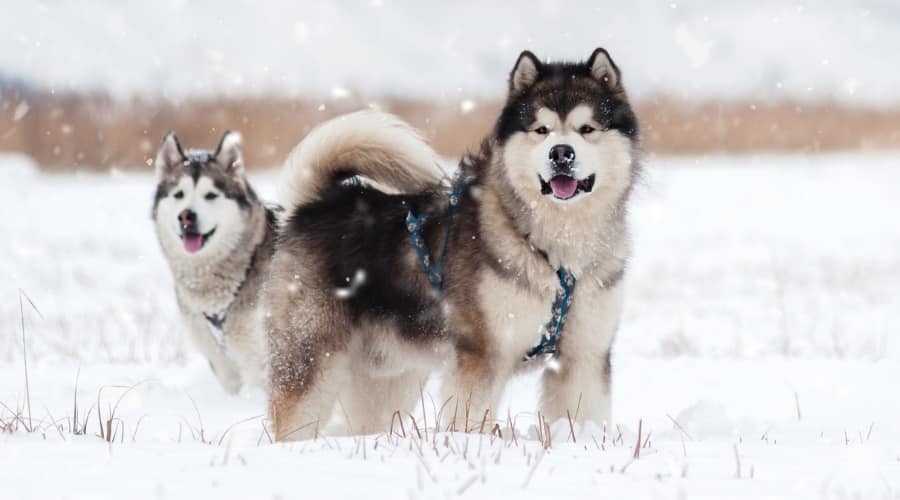
The Alaskan Malamute is a pack dog. Meaning that he loves to spend most, if not all, of his time with his humans. For this reason, he is only suited to families who can spend most of their time with him. If you work long hours or travel away from home dog-free, this is not the breed for you. But if you are looking for a needy hot water bottle, this is definitely the breed for you.
As a pack dog, you can also be sure that he needs a pack leader. You need to make sure that it’s you and not him. Family dogs who feel a lack of leadership will challenge their master for the role of top dog. This can lead to unhappy dynamics, behavioral problems, and unruly dogs. For this reason, the Malamute needs to be homed with a family with previous dog ownership.
He is a determined dog who likes to have a job to do. Whether that means pulling carts on a ranch or playing and training for hours on end, he needs to stay busy. He isn’t a couch potato, and if you are, he’s going to be tough to manage. You might think that this breed is great for protection, but this is not the case. Although many intruders will be put off by his size, most Malamutes would rather lick newcomers than chase them off.
He also has some kooky traits. Although he rarely barks, he loves to howl, or ‘woo woo’ as it sounds. Sirens, musical instruments, and others singing will set him off, and as long as your neighbors don’t mind, it’s great fun to ‘woo woo’ with him. He also loves to dig, which may be difficult to stop with this breed.
Size & Appearance
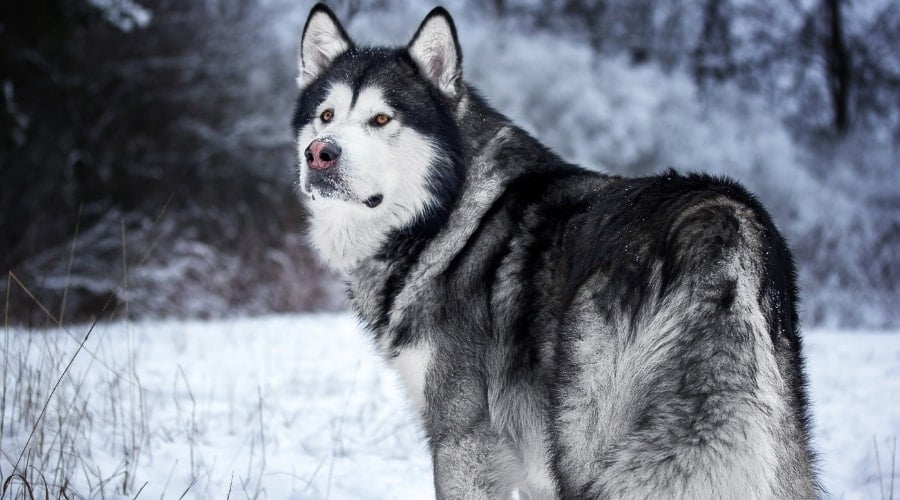
The Alaskan Malamute is a substantially built, powerful dog that falls into the large-sized dog category. To put it into perspective, at 23 to 25 inches tall, he is roughly the same height as the better-known German Shepherd. The breed standard states that females weigh around 75 pounds and males weigh around 85 pounds. Overall, his fluffy coat makes him look a lot bigger than this.
He has a deep chest and broad shoulders that allow him to pull heavy weights. His thighs are thick and muscular, allowing him to pull tremendous loads too. His head is broad but in proportion to the rest of his body, with a cheeky smile. He has wolf-like ears that are triangular and rounded at the tips. His topline slopes slightly towards the rear, and he has a well-furred tail that plumes.
With a soft expression, he always looks friendly and approachable. His eyes are almond-shaped and medium-sized. Some Malamutes have blue eyes, but most have dark-colored eyes. If you want to show your dog in the conformation ring, a blue-eyed dog will be disqualified. Some will also have heterochromia, which is where they have different colored eyes like his Husky cousin.
Coat & Colors
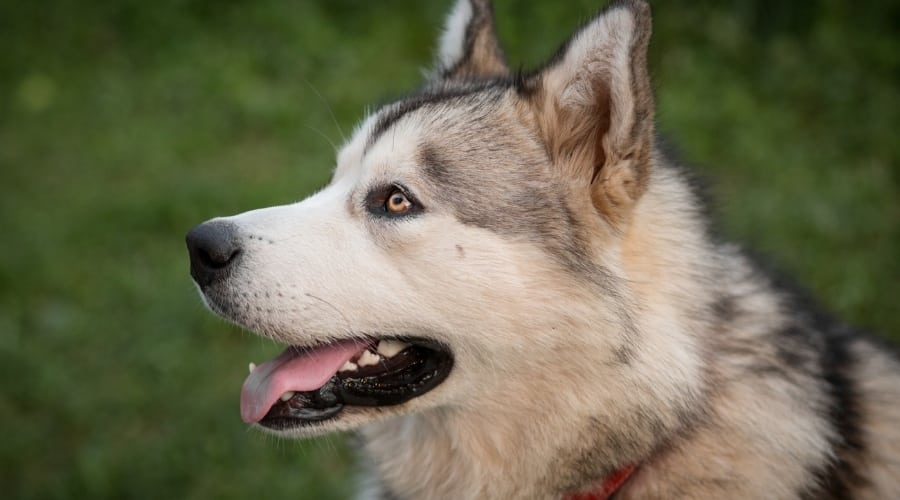
The Alaskan Malamute has a super thick double coat – one of the fluffiest on the planet. Super soft to the touch, you can bury your face into it and fall asleep for hours! His underlayer is dense, wooly, and oily, which keeps him warm in his homeland’s freezing climates. His weather-resistant outer coat is of medium length, straight, thick, and hard, which helps to keep his underlayer dry.
The breed has a variety of different coat colors to choose from. But they mostly all include white and the typical Malamute and Husky facial mask markings. The base color of all dogs is white, and some sport an entirely white coat. The secondary color varies from light gray to black or sable to red. The agouti color is a mixture of black pigments in hair strands, giving it a salt-and-pepper appearance.
Overall, it’s safe to say if you don’t like tufts of hair floating around the house, this is not the breed for you. He is a moderate shedder all year round and a very heavy shedder during the shedding seasons. But he makes up for it by keeping himself super clean. We have a whole section dedicated to his grooming regime later on.
Exercise Requirements
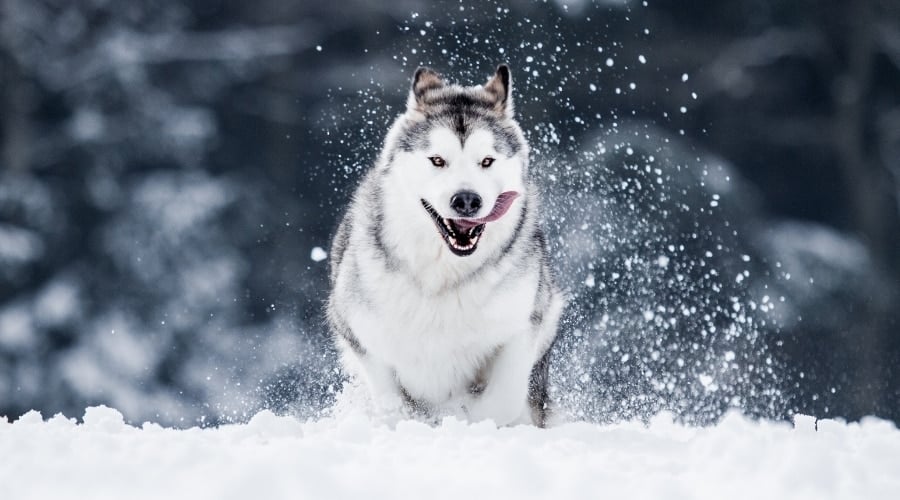
The Alaskan Malamute is a very energetic dog who needs lots of activity to stay fit and healthy. He’ll need at least 90 minutes of exercise every day. This cannot be limited to a long stroll around the block, it needs to be intense. And because he is intelligent, his activities also need to be varied to prevent him from becoming bored. You best get your thinking cap on and mix his schedule up! If he is socialized well, he will also appreciate regular visits to the local doggy park, where he can make new friends.
If you can, once he is fully mature, we’d suggest involving some sort of pulling activity so that he can top up his sledding fix. It can be as simple as getting him to carry the family rucksack on long adventures! His love to chase, play, and dig will mean he is happy to partake in various activities. Including a trip to the beach (just don’t stand behind him when he starts shoveling sand) and fetching in the woods. Skijoring is a favorite pastime of his, which is pulling a person on skis. Be sure to look for your local dog sled racing club!
He does have a high prey drive, which, again, goes back to his hunting days. This is something to bear in mind when out in public because he will run if he sees something fast and furry. From cats to rats, they best beware. As should you! Because this cart-pulling machine will easily whip you off your feet. We advise keeping this big pooch on a leash in public and staying alert.
Living Conditions
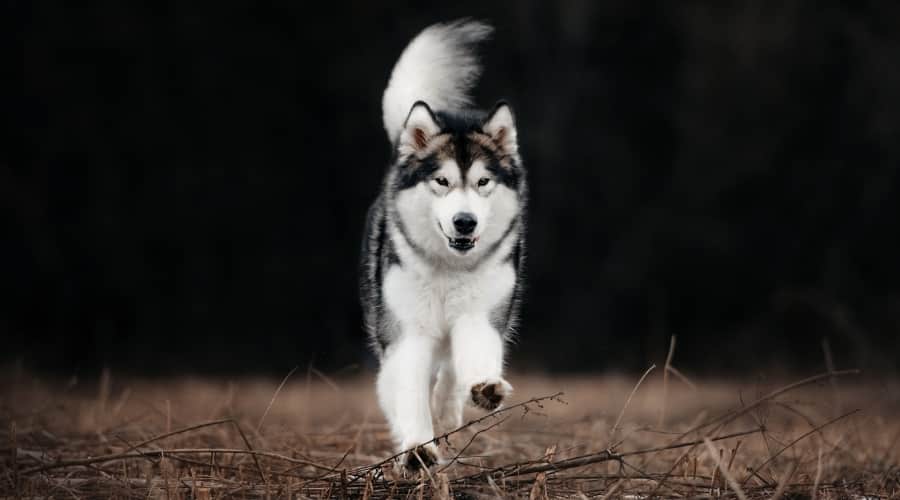
As a large-sized dog, he needs a large-sized home. He will also need access to the outdoors, so yardless homes are a no-go. He is an outdoorsy dog who needs fresh air to maintain his sanity. The Malamute is an escape artist, and because he trusts everyone, he will wander off without looking back at his family. And his love for digging means that he’ll easily tunnel himself out. So, high fences that dig into the ground are essential. Malamutes also live their best life in moderate or colder climates.
The Alaskan Malamute is a friendly pooch who loves his humans, both kids and adults alike. But his large body and love of snuggling mean that he could easily smother infants and young children. Many advise that only older families should take this guy on. But equally, some say he is a great option for younger families. Whatever you decide, always supervise dogs and children.
When it comes to getting on with other dogs, it all comes down to his socialization as a pup. If not socialized, like all dogs, he will not give them the warmest of welcomes. But if he was socialized well, he usually loves the company of other dogs. His high prey drive means that he is not suited to non-canine multi-pet households, and he has been known to harm family cats and rodents. Small furry dogs might not make the best addition to a Malamute household, either.
Training
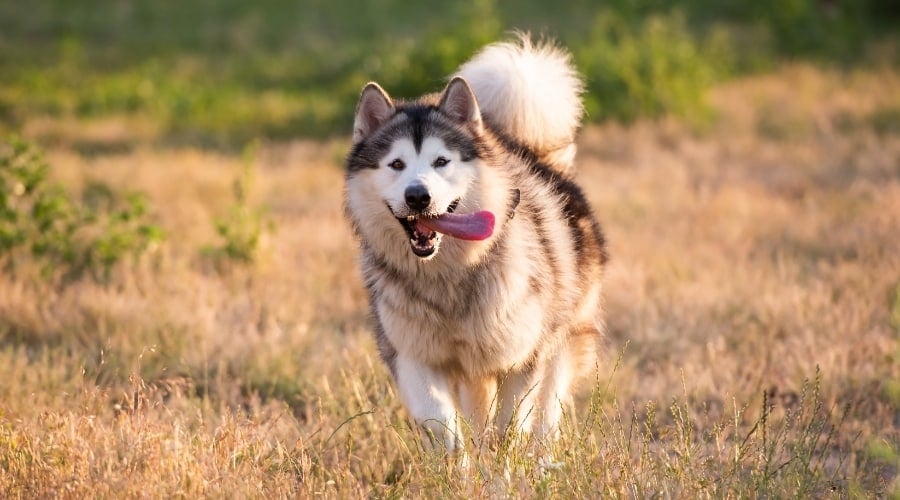
The Alaskan Malamute is a headstrong pack dog. This means two things. The first is that he needs an equally strong-willed master who will enforce the pack rules. Secondly, the Mal is a stubborn dog who is not the easiest dog to train. This is why we only recommend experienced dog owners take the Mal on. It also means that you’ve got your work cut out, but it will be worth it!
Early training is key with this breed. The most critical socialization period is between 3 and 17 weeks. But you will have to continue this as soon as you get him home if you want him to grow into a polite pup. Another great way to socialize him is to enroll him in a puppy obedience class. Here he will learn the basic commands, and it will establish your leadership role.
Obedience classes have a variety of benefits, especially for stubborn dog breeds. It’s important to be persistent with your training, and it will be a lifelong commitment as well as getting the whole family involved so that he knows that he isn’t to get bossy with children or the smaller members of the family.
Another training aspect that is important for this breed is leash training. He is one of the strongest dogs on the planet, built to be a freight machine. So, pulling you over will be a daily occurrence if you do not teach him how to walk on a leash. Learn about leash training your Malamute, start him young, and reward him for good behavior. You can also use a breed-appropriate harness, but beware – the Malamute loves to pull.
Health
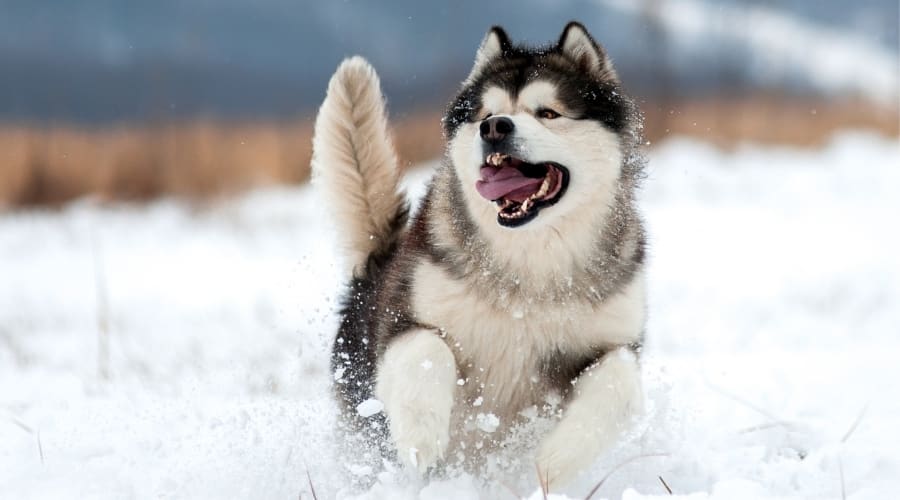
The Alaskan Malamute is a very healthy dog breed who is expected to enjoy an average lifespan of 10 to 14 years. Of course, you need to do your bit as a dog mom or dad to keep him as healthy and fit as possible. Feeding him the best quality nutrition, exercising him well, and keeping up to date with his veterinary checkups are the best ways to keep him in the best shape.
The breed is prone to particular health concerns. Although this list isn’t exhaustive, the below health conditions are the most important to look out for in the breed. Learn about them and what symptoms to look for. A good breeder will discuss these concerns with you and provide health certificates.
Hip Dysplasia
This is where the hip joint grows at an uneven rate and develops abnormally. The uneven growth causes the joint to grind during movement. Over time, it becomes painful and causes mobility issues. Symptoms such as struggling movement, being unable to climb stairs, or getting up from lying down are the most common signs. This is common in large dog breeds, and breeders should only breed dogs with good hip scores.
Eye Conditions
The Mal is prone to various eye conditions, such as progressive retinal atrophy and cataracts. The most prevalent in the breed is cone degeneration disease, also known as day blindness. The cone-shaped cells in his eyes are irritated by bright light, and he essentially becomes blind during the day. At night, his vision is much better. Bumping into objects and being fearful of brightly lit areas are symptoms of this.
Alaskan Malamute Polyneuropathy
This is unique to the breed, and it causes the reduced stimulation of the peripheral nervous system. Degeneration of his nerves and muscles usually occurs during the first two years of his life. Eventually, affected dogs will lose control of their limbs. This condition can be identified by a DNA health test, and affected dogs should not be bred.
Chondrodysplasia
This occurs when the cartilage grows abnormally during pregnancy and essentially causes dwarfism in puppies. From four months onwards, it will be clear that he is not developing as he should. Often keeping his puppy teeth and not developing sexual organs. Chondrodysplasia will affect his long-term health, and it can cause heart problems, joint pain, and a shortened life span.
Nutrition
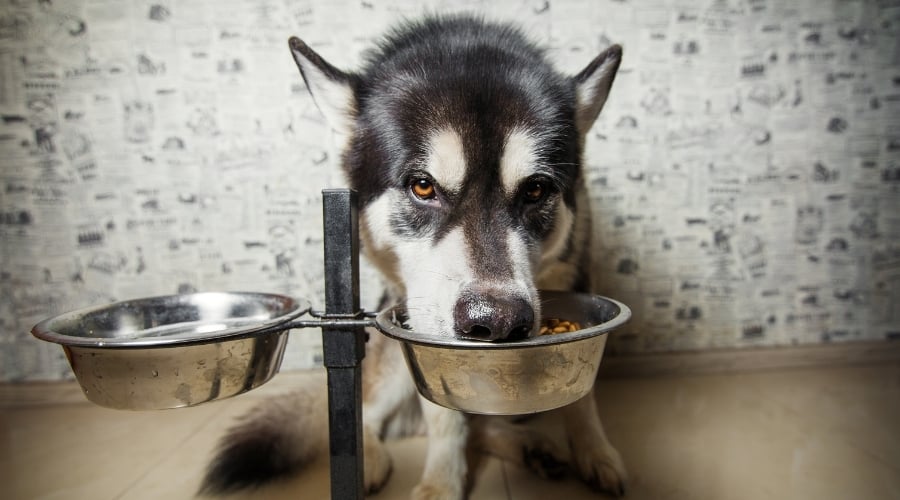
The Alaskan Malamute is a large dog who will consume around four cups of kibble every day. If he is a working dog who pulls carts all day long, he will need more than this. Always follow the instructions on the food packaging according to his age, weight, and energy levels. The breed is prone to obesity if not exercised adequately. So it’s important not to overfeed him.
Feeding your Malamute the best quality nutrition that you can afford is crucial to his health. High-quality kibbles will provide all the food his body needs and provide a well-balanced diet. It’s important to feed him a kibble specifically designed for large breeds. This is particularly important during puppyhood. Large breed puppy kibbles will control the rate at which his bones grow, decreasing the likelihood of hip dysplasia.
Healthy omega fats are important for the breed. It will nourish his skin from the inside out, promoting a luscious coat. It also helps with brain and eye function, vitamins and mineral absorption, joint support, and overall wellness. Look for ingredients such as fish, meat meals, animal and plant oils, and flaxseed. More often than not, lower-budget kibbles do not contain enough healthy omega fats.
Grooming
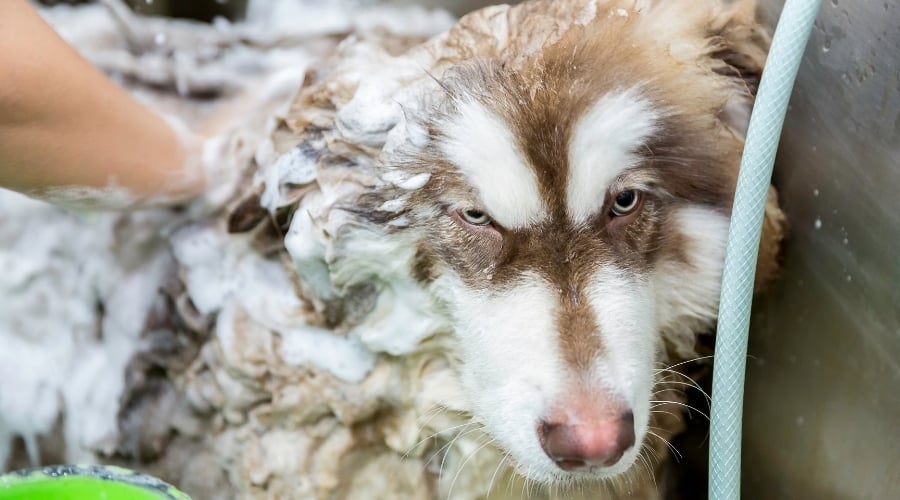
The Alaskan Malamute has a double coat that requires regular brushing. He is a moderate shedder throughout the year. Meaning that he will need two or three weekly brushing sessions to manage his jacket. A pin brush is the best tool for their coat. During the shedding seasons, leading up to summer and winter, he will need brushing every day. A deshedding tool like the Furminator will also help you to manage his sheer amount of fluff.
Believe it or not, this is a relatively clean breed. Not only because his coat will repel water and dirt, but he will thoroughly groom himself clean after exercise. He will need bathing once every eight weeks to keep his coat in the best condition. Use a doggy shampoo designed for thick coats, such as a high-quality concentrated shampoo. Dry him thoroughly because a damp coat can lead to infections, hot spots, and even mold.
Their teeth need to be brushed weekly with a doggy toothpaste to avoid periodontal diseases. Trim his nails as and when you can hear them tapping on the floor, and clean his ears once a week to prevent the build-up of bacteria. Despite being a big dog, he doesn’t drool that much. This is because his dewlaps turn inwards, which prevents them from freezing in Alaska.
Breeders & Puppy Costs
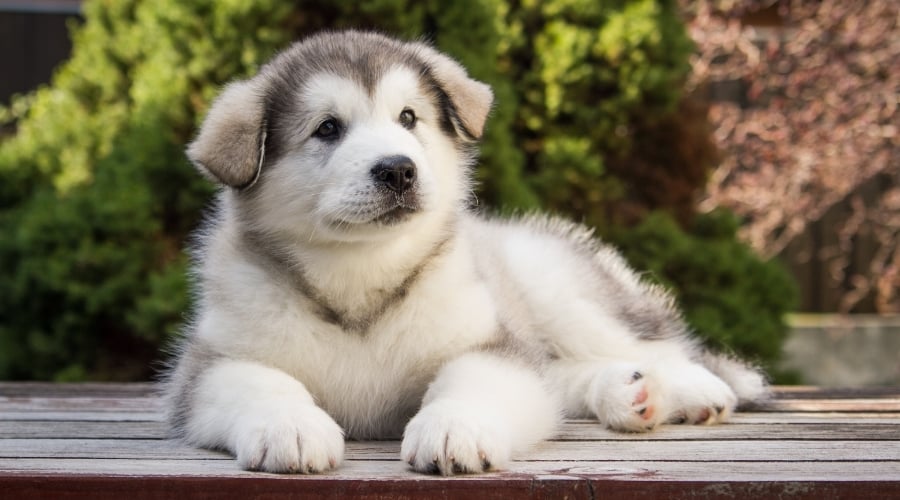
To find a good quality Alaskan Malamute breeder, you might have to travel. You should also expect to be placed on a waiting list. But this is a good thing! It means that the breeder is taking care and breeding with best practices. Be sure to meet them in person, including the puppies and their parents. Look for a clean environment and healthy pups, and ask for the health certificates we mentioned earlier.
The average price of a purebred puppy from a reputable breeder is around $1,500 and up. This is a reasonable price for a large breed puppy who has received all the treatment, love, and socialization he needs. The AKC list of Malamute breeders is a great place to start your search for a good quality breeder.
Never work with a puppy mill or someone who doesn’t meet the standards of a good quality breeder. If they pressure you into a sale, ask for money before meeting the pup, meet you somewhere obscure like a parking lot, or cannot offer health certificates, walk away! Not only will you likely receive an unhealthy pup, but they will have untold behavioral problems.
Rescues & Shelters
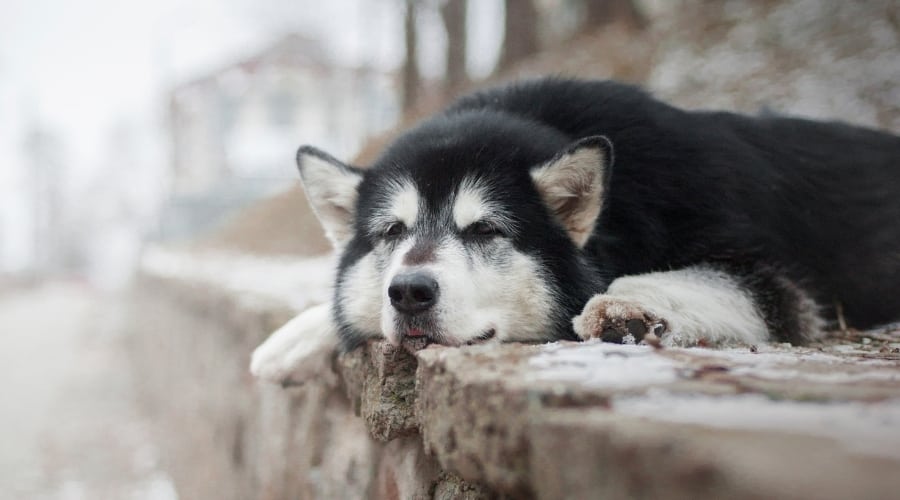
There are millions of dogs in America waiting in rescue shelters for their forever homes. So why not consider adopting an Alaskan Malamute? Search for your local rescue shelters online and head out with the whole family in search of your soon-to-be canine companion. Speak to the staff there, who will be more than happy to talk you through the rescue process.
If you cannot find the right pooch for you, fear not. There are many breed dedicated rescue organizations across the country that rehome Malamutes and their mixes. The Alaskan Malamute Assistance League list dedicated rescue centers state by state. They also have a contact form should you have any questions. There are rescue fees, but they are often much lower than buying a puppy from a breeder.
As Family Pets
- Malamutes are pack dogs and thrive around their family and other dogs.
- They crave the company of their humans, making them very needy.
- He has a lot of energy and needs at least 90 minutes of intense daily exercise.
- He is super friendly with visitors and strangers.
- This means he’s typically a terrible guard dog.
- Malamutes are very affectionate with their families.
- They enjoy spending time cuddled up near the couch.
- Malamutes love to howl and dig.
- They are great fun and entertainment for the whole family.
- He needs an experienced dog owner who can control his dominant character.
- The Malamute has a high prey drive and wandering potential.
- He needs lots of space in his family home and a secure yard.
- Due to his size, a family with older children is his ideal family.
Final Thoughts
The Alaskan Malamute is a large dog with a fluffy exterior and an equally soft personality. This big sweetie loves his human pack, and as a result, he can be a needy and intense pooch. As a pack dog, he needs strong leadership, too, making him unsuitable for novice dog owners. His higher-than-average energy levels means that he needs to be placed with a very active family.
As long as you can meet his needs, he is a delightful canine companion who’s well-suited to put a smile on everyone’s face. Except for the neighbor’s cat! He makes a wonderful family pet for the right family and will bring wild wolfiness into your life. Prepare for lots of fluff but also lots of canine companionship.



